| Walter Reed Army Medical Center | |
|---|---|
 Walter Reed Medical Center's Building 1 prior to its 2011 closing | |
| Founded | 1 May 1909 |
| Disbanded | 27 August 2011 |
| Country | |
| Branch | |
| Type | Hospital |
| Role | Militarized healthcare |
| Motto(s) | "We Provide Warrior Care" |
| Commanders | |
| Notable commanders | LTG Kevin C. Kiley (2002 – June 2004; 1–2 March 2007) MG Kenneth L. Farmer Jr. (June 2004 – 25 Aug. 2006) MG. George W. Weightman (25 Aug. 2006 – 1 March 2007) MG Carla Hawley-Bowland (final commander) |
| Walter Reed Army Medical Center | |
|---|---|
| Walter Reed Health Care System | |
 The WRAMC distinctive unit insignia | |
| Geography | |
| Location | 6900 Georgia Avenue NW, Washington, D.C., United States |
| Coordinates | 38°58′30″N 77°01′48″W / 38.975°N 77.03°W |
| Organization | |
| Care system | Military |
| Type | General |
| History | |
| Opened | 1 May 1909 |
| Links | |
| Website | Walter Reed National Military Center |
| Lists | Hospitals in Washington, D.C. |
Walter Reed Army Medical Center (WRAMC) Historic District | |
| NRHP reference No. | 15000061 |
| Added to NRHP | 9 March 2015 |
The Walter Reed Army Medical Center (WRAMC), officially known as Walter Reed General Hospital (WRGH) until 1951, was the U.S. Army's flagship medical center from 1909 to 2011. Located on 113 acres (46 ha) in Washington, D.C., it served more than 150,000 active and retired personnel from all branches of the United States Armed Forces. The center was named after Walter Reed, a U.S. Army physician and sergeant who led the team that confirmed that yellow fever is transmitted by mosquitoes rather than direct physical contact.
Since its origins, medical care at the facility grew from a bed capacity of 80 patients to approximately 5,500 rooms covering more than 28 acres (11 ha) of floor space. WRAMC combined with the National Naval Medical Center at Bethesda, Maryland in 2011 to form the tri-service Walter Reed National Military Medical Center (WRNMMC). The grounds and historic buildings of the old campus are being redeveloped as the Parks at Walter Reed.[1]
History
Origins at Fort McNair
Fort Lesley J. McNair, located in the southwest of the District of Columbia on land set aside by George Washington as a military reservation, is the third oldest U.S. Army installation in continuous use in the United States after West Point and Carlisle Barracks. Its position at the confluence of the Anacostia River and the Potomac River made it an excellent site for the defense of the nation's capital. Dating back to 1791, the post served as an arsenal, played an important role in the nation's defense, and housed the first U.S. Federal Penitentiary from 1839 to 1862.
Today, Fort McNair enjoys a strong tradition as the intellectual headquarters for defense. Furthermore, with unparalleled vistas of the picturesque waterfront and the opposing Virginia shoreline, the historic health clinic at Fort McNair, the precursor of today's Walter Reed Army Medical Center (WRAMC), overlooks the residences of top officials who choose the famed facility for the delivery of their health care needs.
"Walter Reed's Clinic," the location of the present day health clinic at Washington, D.C., occupies what was from 1898 until 1909 the General Hospital at what was then Washington Barracks, long before the post was renamed in honor of Lt. Gen. McNair who was killed in 1944. The hospital served as the forerunner of Walter Reed General Hospital; however, the Victorian era waterfront dispensary remains and is perhaps one of America's most historically significant military medical treatment facilities. It is reported that Walter Reed lived and worked in the facility when he was assigned as Camp Surgeon from 1881 to 1882. After having served on other assignments, he returned as Professor of Medicine and Curator of the Army Medical Museum. Some of his epidemiological work included studies at Washington Barracks, and he is best known for discovering the transmission of yellow fever. In 1902, Major Reed underwent emergency surgery here for appendicitis and died of complications in this U.S. Army Medical Treatment Facility (MTF), within the very walls of what became his final military duty assignment.[2]
Regarding the structure itself, since the 1890s the health clinic was used as an Army General Hospital where physicians, corpsmen and nurses were trained in military health care. In 1899, the morgue was constructed which now houses the Dental Clinic, and in 1901 the hospital became an entirely separate command. This new organizational command relocated eight years later with the aide of horse-drawn wagons and an experimental steam driven ambulance in 1909. Departing from the 50-bed hospital, as documented in The Army Nursing Newsletter, Volume 99, Issue 2, February 2000,[3] they set out due north transporting with them 11 patients initially to the new 65-bed facility in the northern aspect of the capital. Having departed Ft. McNair, the organization has since developed into the Walter Reed Army Medical Center that we know today.
As for the facility they left behind at Fort McNair, it functioned in a smaller role as a post hospital until 1911 when the west wing was converted into a clinic.
Walter Reed General Hospital and WRAMC
Congressional legislation appropriated $192,000 for the construction of Walter Reed General Hospital[4] (WRGH, now known as "Building 1"), and the first ten patients were admitted on 1 May 1909. Lieutenant Colonel William Cline Borden was the initiator, planner and effective mover for the creation, location, and first Congressional support of the Medical Center. Due to his efforts, the facility was nicknamed "Borden's Dream."[5]
In 1923, General John J. Pershing signed the War Department order creating the "Army Medical Center" (AMC) within the same campus as the WRGH. (At this time, the Army Medical School was relocated from 604 Louisiana Avenue and became the "Medical Department Professional Service School" (MDPSS) in the new Building 40.) Pershing lived at Walter Reed from 1944 until his death there 15 July 1948.

In September 1951, "General Order Number 8" combined the WRGH with the AMC, and the entire complex of 100 rose-brick Georgian Revival style buildings was at that time renamed the "Walter Reed Army Medical Center" (WRAMC). In June 1955, the Armed Forces Institute of Pathology (AFIP) occupied the new Building 54 and, in November, what had been MDPSS was renamed the Walter Reed Army Institute of Research (WRAIR). 1964 saw the birth of the Walter Reed Army Institute of Nursing (WRAIN). Former President Dwight D. Eisenhower died at WRAMC on 28 March 1969.
Starting in 1972, a huge new WRAMC building (Building 2) was constructed and made ready for occupation by 1977. WRAIR moved from Building 40 to a large new facility on the WRAMC Forest Glen Annex in Maryland in 1999. Subsequently, Building 40 was slated for renovation under an enhanced use lease by a private developer.
In 2007, the University of Pennsylvania and WRAMC established a partnership whereby proton therapy technology would be available to treat United States military personnel and veterans in the Perelman Center for Advanced Medicine's new Roberts Proton Therapy Center.[6][7]
2007 neglect scandal
In February 2007, The Washington Post published a series of investigative articles outlining cases of alleged neglect (physical deterioration of housing quarters outside hospital grounds, bureaucratic nightmares, etc.) at WRAMC as reported by outpatient soldiers and their families. A scandal and media furor quickly developed resulting in the firing of the WRAMC commanding general Maj. Gen. George W. Weightman,[8] the resignation of Secretary of the Army Francis J. Harvey (reportedly at the request of Secretary of Defense Robert Gates[9]), the forced resignation of Lt. Gen. Kevin C. Kiley, hospital commander from 2002 to 2004.[10] Congressional committee hearings were called and numerous politicians weighed in on the matter including President George W. Bush, who had appointed Harvey, and Vice-president Dick Cheney. Several independent governmental investigations are ongoing and the controversy has spread to other military health facilities and the Department of Veterans Affairs health care system.
2005 BRAC recommendation and 2011 closure

As part of a Base Realignment and Closure announcement on 13 May 2005, the Department of Defense proposed replacing Walter Reed Army Medical Center with a new Walter Reed National Military Medical Center (WRNMMC); the new center would be on the grounds of the National Naval Medical Center in Bethesda, Maryland, seven miles (11 km) from WRAMC's location in Washington, D.C. The proposal was part of a program to transform medical facilities into joint facilities, with staff including Army, Navy, and Air Force medical personnel.
On 25 August 2005, the BRAC Committee recommended passage of the plans for the WRNMMC. The transfer of services from the existing to the new facilities was gradual to allow for continuity of care for the thousands of service members, retirees and family members that depended upon WRAMC. The end of operations at the WRAMC facility occurred on 27 August 2011.[11] The Army says the cost of closing that hospital and consolidating it with Bethesda Naval Medical Center in suburban Maryland more than doubled to $2.6 billion since the plan was announced in 2005 by the Base Realignment and Closing Commission.[12]
Gallery
 Main Building
Main Building East wing of Main Building
East wing of Main Building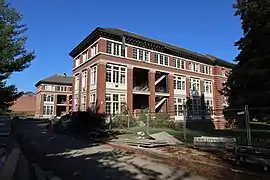 West wing of Main Building
West wing of Main Building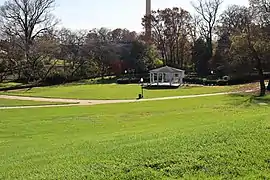 Great Lawn
Great Lawn Buildings 8 and 9
Buildings 8 and 9 Building 12
Building 12 Borden Pavilion
Borden Pavilion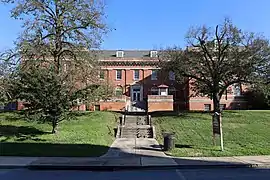 Building 7
Building 7 Vaccaro Hall
Vaccaro Hall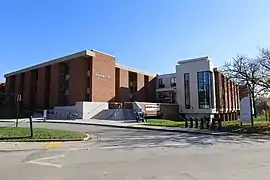 Abrams Hall
Abrams Hall Wagner Sports Center
Wagner Sports Center Mologne House
Mologne House Power plant
Power plant Doss Memorial Hall
Doss Memorial Hall Walter Reed Monument
Walter Reed Monument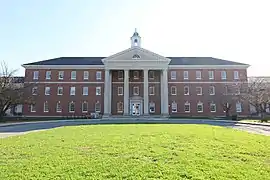 Delano Hall
Delano Hall Building T20
Building T20
 Building 21
Building 21 Memorial Chapel
Memorial Chapel Fisher House
Fisher House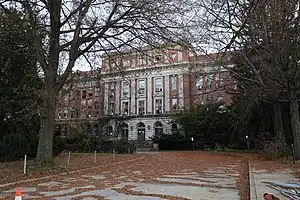
 Building 52
Building 52 Old Red Cross Building
Old Red Cross Building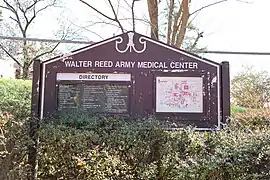 Campus map
Campus map
Notable patients
- Creighton W. Abrams (1914–1974) US Army Chief of Staff; Deputy Commander and commander, Military Assistance Command, Vietnam.
- Joseph Beacham (1874–1958) US Army Brigadier General, head football coach at Cornell and the United States Military Academy.
- Charles Billingslea (1914–1989) US Army Major General, recipient of two Distinguished Service Crosses.
- Aaron Bradshaw Jr. (1894–1976) US Army Major General, Commanding General, Anti-Aircraft Artillery, U.S. Fifth Army during World War II.
- Roger Brooke (1878–1940) US Army Brigadier General and physician, Namesake of Brooke Army Medical Center, Fort Sam Houston, Texas.[13]
- Fox Conner (1874–1951) US Army major general, Deputy US Army Chief of Staff, "The man who made Eisenhower."
- Carl Rogers Darnall (1867–1941) US Army Brigadier General and physician. Credited with developing the technique of liquid chlorination of drinking water. Commander of the Army Medical Center 1929–31. Namesake of Carl R. Darnall Army Medical Center, Fort Cavazos, TX.
- Everett M. Dirksen (1896–1969) US Senator from Illinois.
- William J. Donovan (1883–1959) US Army Major General, Medal of Honor recipient and Office of Strategic Services founder.
- John Foster Dulles (1888–1959) US Secretary of State; US Senator from New York
- Dwight D. Eisenhower (1890–1969) General of the Army during World War II; Supreme Allied Commander, Europe; 34th President of the United States.
- Mamie Eisenhower (1896–1979) First Lady of the United States and wife of Dwight D. Eisenhower.
- Francis Henry French (1857–1921) US Army Major General.[14]
- Leslie R. Groves (1896–1970) US Army Lieutenant General, Builder of the Pentagon (United States) and Leader of the Manhattan Project
- Paul Ramsey Hawley (1891–1965) US Army Major General; Chief Surgeon, European Theater of Operations 1943–45; Chief Medical officer, Veterans' Administration 1946–47.
- Leonard D. Heaton (1902–1983) US Army Lieutenant General. Surgeon General of the United States Army 1959–69. Commander of Walter Reed 1953–59.
- Leland Stanford Hobbs (1892–1966). US Army Major General; Commander of IX Corps and 30th Infantry Division in World War II.
- Edgar Erskine Hume (1889–1952) US Army Major General; Command Surgeon, US Far Eastern Command; Command Surgeon, UN Forces in Korea; Chief Surgeon, US Occupying Force in Austria.
- Merritte W. Ireland (1867–1952) US Army Major General; Surgeon General of the United States Army 1918–31. Namesake of Ireland Army Community Hospital, Fort Knox
- Cheddi Jagan (1918–1997) 4th President of Guyana, 1st Premier of British Guiana, and 1st Chief Minister of British Guiana[15][16]
- Norman T. Kirk (1888–1960) US Army Major General; Surgeon General of the United States Army 1943–47.
- Julian Robert Lindsey (1871−1948), U.S. Brigadier General, Commander, 164th Infantry Brigade, 82nd Division, American Expeditionary Forces
- Douglas MacArthur (1880–1964) US General of the Army, Supreme Commander for the Allied Powers Southwest Pacific Area, US Army Chief of Staff, and U.S. Military Academy Superintendent.
- James C. Magee (1883–1975) US Army Major General; Surgeon General of the United States Army 1939–43.[17]
- Mike Mansfield (1903–2001) US Senator from Montana. US Navy Seamen, US Army Private, and US Marine Corps Private First Class
- Peyton C. March (1864–1955) US Army Chief of Staff. US Army General [18]
- George Catlett Marshall Jr. (1880–1959) US General of the Army, US Army Chief of Staff, Secretary of State, Secretary of Defense, Nobel Peace Laureate.
- John von Neumann (1903–1957), mathematician. Credited with developing the concept of mutual assured destruction.
- William Charles Ocker (1880–1942) American aviation pioneer, "Father of instrument flying."
- Mason Patrick (1863–1942) US Army Major General; Chief of United States Air Service; Chief of United States Air Corps[19]
- John J. Pershing (1860–1948), U.S. General of the Armies, Commander, American Expeditionary Forces during World War I, US Army Chief of Staff.
- Chough Pyung-ok (1894–1960) South Korean politician.
- Walter L. Reed (1877–1956) US Army Major General; Inspector General of the U.S. Army; son of Major Walter Reed, namesake of the hospital[20]
- Daniel Isom Sultan (1885-1947),U.S. Lieutenant General, CG 38th Infantry Division, CG VIII Corps, Deputy Commander Burma-India Theater, Inspector General of the U.S. Army
- Andrew Tate (1986-), American-British Kickboxing Champion 4 times World Kickboxing Champion
- William M. Wright (1863−1943), U.S. Lieutenant General, CG 89th Division, World War I
Tenants
In addition to the WRAMC hospital complex, the WRAMC installation hosted a number of other related activities and organizations.
- The North Atlantic Regional Medical Command
- The North Atlantic Regional Dental Command
- The Armed Forces Institute of Pathology (AFIP)
- The Uniformed Services University of the Health Sciences (USUHS)
- United States Army Institute of Dental Research (USAIDR)
- The DOD Deployment Health Clinical Center
- The National Museum of Health and Medicine (NMHM) was co-located in the same building with the AFIP. The NMHM reopened 15 September 2011 on Fort Detrick Forest Glen Annex in Silver Spring, Maryland.
- The Borden Institute, a "Center of Excellence in Military Medical Research and Education".
- The Walter Reed Army Institute of Research (WRAIR), formerly in Building 40 on the Georgia Avenue campus. This medical research institute moved to WRAMC's Forest Glen Annex in 1999. In 2008, authority over the Annex was transferred to Fort Detrick in preparation for WRAMC's 2011 move/closure.
Commanding officers
Although after 1992 officers of any branch of the Army Medical Department could command medical treatment facilities, every commander of the Walter Reed Army Medical Center was a member of the Army Medical Corps.
Walter Reed Army Medical Center[21]
| Image | Rank | Name | Begin date | End date | Notes |
|---|---|---|---|---|---|
 | Major General | Carla G. Hawley-Bowland | December 2007 | 29 July 2011 | Cased the Medical Center colors |
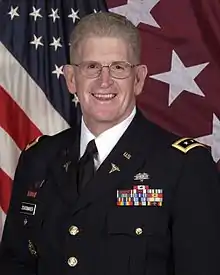 | Major General | Eric B. Schoomaker | March 2007 | November 2007 | Later Surgeon General of the Army |
 | Lieutenant General | Kevin C. Kiley | 1 March 2007 | 2 March 2007 | Simultaneously serving as Surgeon General of the Army |
 | Major General | George W. Weightman | August 2006 | 1 March 2007 | |
 | Major General | Kenneth L. Farmer Jr. | June 2004 | August 2006 | |
 | Major General | Kevin C. Kiley | June 2002 | June 2004 | Later Surgeon General of the Army |
 | Major General | Harold L. Timboe | May 1999 | June 2002 | |
 | Major General | Leslie M. Burger | November 1996 | May 1999 | |
 | Major General | Ronald R. Blanck | October 1992 | October 1996 | Later Surgeon General of the Army |
 | Major General | Richard D. Cameron | May 1989 | October 1992 | Later Commanding General, United States Army Health Services Command |
 | Colonel | James E. Hastings | March 1989 | May 1989 | |
 | Major General | James H. Rumbaugh | August 1988 | March 1989 | Died while in command |
 | Major General | Louis A. Malogne | June 1983 | August 1988 | Medically retired 1 August 1988; died 22 August 1988 |
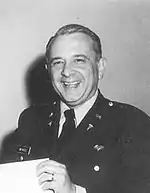 | Major General | Enrique Mendez Jr. | October 1981 | June 1983 | Later Assistant Secretary of Defense (Health Affairs) |
 | Major General | Bernard T. Mittemeyer | June 1980 | September 1981 | Later Surgeon General of the Army |
 | Major General | George I. Baker | March 1978 | June 1980 | |
 | Major General | Robert Bernstein | June 1973 | February 1978 | Previously Command Surgeon, Military Assistance Command Vietnam |
 | Major General | William H. Moncrief | May 1972 | April 1973 | |
 | Brigadier General | William H. Meroney | April 1972 | May 1972 | |
 | Major General | Colin F. Vorder Brugge | January 1971 | March 1972 | |
 | Major General | Carl W. Hughes | November 1970 | January 1971 | |
 | Major General | Glenn J. Collins | June 1969 | October 1970 | Previously Commanding General 44th Medical Brigade and Command Surgeon, United States Army, Vietnam |
 | Major General | Phillip W. Mallory | May 1967 | June 1969 | |
 | Major General | Douglas O. Kendrick | June 1965 | March 1967 | |
 | Major General | Achilles L. Tynes | September 1962 | May 1965 | |
 | Major General | Clinton S. Lyter | May 1961 | September 1962 | |
 | Major General | C. F. St. John | July 1959 | April 1961 | |
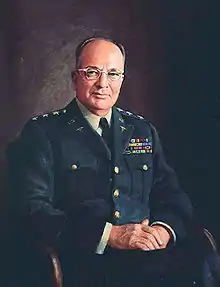 | Major General | Leonard D. Heaton | April 1953 | June 1959 | Later Surgeon General of the Army |
 | Major General | Paul H. Streit | September 1951 | March 1953 | |
The Army Medical Center[22]
| Image | Rank | Name | Begin Date | End Date | Notes |
|---|---|---|---|---|---|
 | Major General | Paul H. Streit | January 1949 | February 1951 | |
 | Major General | George C. Beach | March 1946 | November 1948 | |
 | Major General | Shelly U. Marietta | February 1941 | February 1946 | |
 | Brigadier General | Raymond F. Metcalfe | December 1939 | January 1941 | |
 | Brigadier General | Wallace C. DeWitt | August 1935 | December 1939 | Namesake of former DeWitt Army Community Hospital, Fort Belvoir, Virginia |
 | Brigadier General | Albert E. Truby | January 1932 | July 1935 | As a lieutenant, Truby served under Walter Reed in Cuba during the yellow fever experiments |
 | Brigadier General | Carl R. Darnall | December 1929 | December 1931 | Namesake of Carl R. Darnall Army Medical Center, Fort Cavazos, Texas |
 | Brigadier General | James M. Kennedy | March 1926 | December 1929 | |
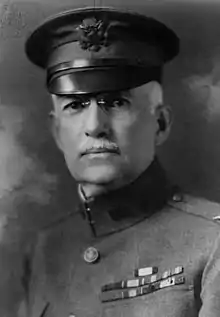 | Brigadier General | James D. Glennan | March 1919 | March 1926 | |
Walter Reed General Hospital[22]
| Image | Rank | Name | Begin date | End date | Notes |
|---|---|---|---|---|---|
 | Brigadier General | James D. Glennan | March 1919 | March 1926 | |
 | Colonel | Edward R. Schreiner | August 1918 | March 1919 | |
 | Colonel | Willard F. Truby | November 1917 | August 1918 | |
 | Colonel | Charles P. Mason | October 1916 | November 1917 | |
 | Major | Percy M. Ashburn | September 1915 | October 1916 | |
 | Colonel | John L. Phillips | May 1914 | September 1915 | |
 | Colonel | Henry C. "Pinky" Fisher | August 1913 | May 1914 | [23] |
 | Colonel | H. P. Birmingham | October 1912 | May 1913 | |
 | Colonel | Charles Richard | September 1911 | September 1912 | |
 | Colonel | William H. Arthur | 1 June 1908 | 11 July 1911 | [24]Worked with Major Walter Reed at the Army Medical Bacteriological Laboratory while stationed at Fort Myer, Virginia, 1895–1897. Retired as a brigadier general in 1918.[25] |
See also
References
- ↑ "About". The Parks at Walter Reed. 19 April 2018. Retrieved 13 April 2020.
- ↑ Adler, 2014
- ↑ "Regional Health Command – Atlantic – Home". www.narmc.amedd.army.mil. Archived from the original on 28 June 2008. Retrieved 2 June 2017.
- ↑ "Hospital Under Way". The Washington Post. 3 February 1907. p. R7. ProQuest 144711780.
- ↑ "Major Walter Reed, Medical Corps, U.S. Army". Archived from the original on 23 October 2007. Retrieved 2 June 2017.
- ↑ "Collaborative Research Effort with the United States Military | Roberts Proton Therapy Center". Pennmedicine.org. Archived from the original on 1 June 2013. Retrieved 22 April 2013.
- ↑ McDonough, J.; Tinnel, B. (August 2007). "The University of Pennsylvania/Walter Reed Army Medical Center proton therapy program". Technol. Cancer Res. Treat. 6 (4 Suppl): 73–76. doi:10.1177/15330346070060S412. PMID 17668956.
- ↑ "Politics News – Breaking Political News, Video & Analysis". ABC News. Archived from the original on 1 June 2017. Retrieved 2 June 2017.
- ↑ "Army secretary resigns in scandal's wake". Archived from the original on 31 December 2015. Retrieved 2 June 2017.
- ↑ "Army's Kiley ousted in Walter Reed furor". Archived from the original on 17 March 2007. Retrieved 2 June 2017.
- ↑ "Walter Reed Army Medical Center closes its doors in final ceremony". CNN. 27 August 2011. Archived from the original on 28 June 2015. Retrieved 16 July 2015.
- ↑ "Health care difficulties in the Big Easy". CNN. 28 February 2006. Archived from the original on 9 February 2012.
- ↑ "Office of Medical History – Brigadier General Roger Brooke". history.amedd.army.mil. Archived from the original on 3 October 2017. Retrieved 2 June 2017.
- ↑ "Gen Francis Henry French Dead". New York Times. 11 March 1921. Archived from the original on 5 March 2016. Retrieved 15 January 2015.
- ↑ "In the Americas", The Miami Herald (nl.newsbank.com), 16 February 1997.
- ↑ Larry Rohter, "Cheddi Jagan, Guyana's Founder, Dies at 78", The New York Times, 7 March 1997.
- ↑ "History". Archived from the original on 12 March 2016. Retrieved 28 April 2016.
- ↑ Mossman, Billy C.; Stark, M. Warner (1972). The Last Salute: Civil and Military Funerals, 1921–1969. Washington, DC: Government Printing Office. pp. 81–86. Archived from the original on 24 September 2015.
- ↑ DuPre, Flint. "U.S. Air Force Biographical Dictionary". United States Air Force. Retrieved 12 July 2019.
- ↑ "Archived copy". Archived (PDF) from the original on 18 February 2013. Retrieved 19 April 2016.
{{cite web}}: CS1 maint: archived copy as title (link) - ↑ Archived 2016-04-27 at the Wayback Machine
- 1 2 "Archived copy". Archived (PDF) from the original on 16 February 2013. Retrieved 12 April 2016.
{{cite web}}: CS1 maint: archived copy as title (link) - ↑ "Archived copy". Archived (PDF) from the original on 16 February 2013. Retrieved 20 April 2016.
{{cite web}}: CS1 maint: archived copy as title (link) - ↑ "Archived copy". Archived (PDF) from the original on 16 February 2013. Retrieved 20 April 2016.
{{cite web}}: CS1 maint: archived copy as title (link) - ↑ "Brigadier General William H. Arthur (1856-1936) :: Army Medical Bulletin, 1922-1949". stimson.contentdm.oclc.org. Archived from the original on 7 May 2016. Retrieved 2 June 2017.
Further reading
- Adler, Jessica L. "The Founding of Walter Reed General Hospital and the Beginning of Modern Institutional Army Medical Care in the United States." Journal of the history of medicine and allied sciences (2014) 69#4 pp. 521–53.
External links
- Walter Reed and Beyond – A Washington Post Investigation
- Wounded Soldiers Hotline
- Soldiers face neglect, frustration at army's top medical facility
- Award winning student film on the controversy at Walter Reed
- The short film Big Picture: The Soldier Patient is available for free viewing and download at the Internet Archive.
- Walter Reed Army Medical Center Documentary produced by WETA-TV
